Karl May
| Karl May | |
|---|---|
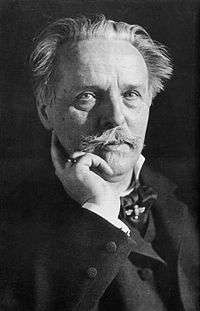 | |
| Born |
Karl Friedrich May 25 February 1842 Ernstthal, Saxony, German Confederation |
| Died |
30 March 1912 (aged 70) Radebeul, German Empire |
| Occupation | Writer; author |
| Nationality | German |
| Genre | Western, travel fiction, 'Heimatromane', adventure novels |
| Website | |
|
www | |
Karl Friedrich May (/maɪ/ MY; German: [maɪ]; also Carl; 25 February 1842 – 30 March 1912) was a German writer best known for his adventure novels set in the American Old West. His main protagonists are Winnetou and Old Shatterhand. May set similar books in the Orient and Middle East in which the main protagonists were Kara Ben Nemsi and Hadschi Halef Omar, Latin America and Germany. May also wrote poetry, a play, and composed music; he was a proficient player of several musical instruments. Many of his works were adapted for film, stage, audio dramas and comics. Later in his career, May turned to philosophical and spiritual genres. He is one of the best-selling German writers of all time with about 200 million copies worldwide.
Life and career
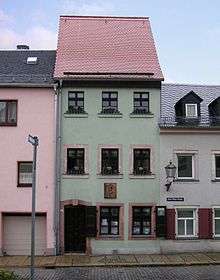
Youth
May was the fifth child of a poor family of weavers in Ernstthal, Schönburgische Rezessherrschaften (then part of the Kingdom of Saxony). He had thirteen siblings of whom nine died in infancy. During his school years, he received tuition in music and composition. At twelve, May was making money at a skittle alley, where he was exposed to rough language.[1]
Delinquency
In 1856, May commenced teacher training in Waldenburg but in 1859 was expelled for stealing six candles. After an appeal, he was allowed to continue in Plauen. Shortly after graduation, when his room mate accused him of stealing a watch, May was jailed in Chemnitz for six weeks and his license to teach was permanently revoked. After this, May worked with little success as a private tutor, an author of tales, a composer and a public speaker. For four years, from 1865 to 1869, May was jailed in the workhouse at Osterstein Castle, Zwickau. With good behaviour, May became an administrator of the prison library which gave him the chance to read widely. He made a list of the works he planned to write (Repertorium C. May.)
On his release, May continued his life of crime. He was arrested, but when he was transported to a crime scene during a judicial investigation, he escaped and fled to Bohemia, where he was detained for vagrancy. For another four years, from 1870 to 1874, May was jailed in Waldheim, Saxony. There he met a Catholic Catechist, Johannes Kochta, who assisted May.
Early years
After his release in May 1874, May returned to his parents' home in Ernstthal and began to write. In November 1874, Die Rose von Ernstthal ("The Rose from Ernstthal") was published.[2] May then became an editor in the publishing house of Heinrich Gotthold Münchmeyer in Dresden. May managed entertainment papers such as Schacht und Hütte ("Bay and Cabin") and continued to publish his own works such as Geographische Predigten ("Collected Travel Stories") (1876). May resigned in 1876[2] and was employed by Bruno Radelli of Dresden.
In 1878, May became a freelance writer. In 1880, he married Emma Pollmer. Once again, May was insolvent.[2] In 1882, May returned to the employ of Münchmeyer and began the first of five large colportage novels. One of these was Das Waldröschen (1882–1884). From 1879, May was also published in Deutscher Hausschatz ("German Treasure House"), a Catholic weekly journal from the press of Friedrich Pustet in Regensburg. In 1880, May began the Orient Cycle, which ran, with interruption, until 1888. May was also published in the teenage boys' journal Der Gute Kamerad ("The Good Comrade") of Wilhelm Spemann, Stuttgart. In 1887, it published Der Sohn des Bärenjägers ("Son of the Bear Hunter"). In 1891 Der Schatz im Silbersee ("The Treasure of Silver Lake") was published. May published in other journals using pseudonyms. In all, he published over one hundred articles. In October 1888, May moved to Kötzschenbroda (a part of Radebeul) and 1891 to Villa Agnes in Oberlößnitz. In 1891, Friedrich Ernst Fehsenfeld offered to print the Deutsche Hausschatz ("Son of the Bear Hunter") stories as books. In 1892, publication of Carl May's Gesammelte Reiseromane (Collected Travel Accounts or Karl May's Gesammelte Reiseerzählungen) brought financial security and recognition. May became deeply absorbed in the stories he wrote and the lives of his characters. Readers wrote to May, addressing him as the protagonists of his books. May conducted talking tours in Germany and Austria and allowed autographed cards to be printed and photos in costume to be taken. In December 1895, May moved to the Villa Shatterhand in Alt-Radebeul, which he purchased from the Ziller brothers.
Later years


In 1899, May travelled to Egypt then Sumatra with his servant, Sejd Hassan. In 1900, he was joined by Klara and Richard Plöhn. The group returned to Radebeul in July 1900. May demonstrated some emotional instability during his travels.[3]
Hermann Cardauns and Rudolf Lebius criticised May for his self-promotion with the Old Shatterhand legend. He was also reproached his writing for the Catholic Deutscher Hausschatz and several Marian calendars. There were also charges of unauthorised book publications and the use of an illegal doctoral degree. In 1902, May did receive an Doctor honoris causa from the Universitas Germana-Americana, Chicago for Im Reiche des Silbernen Löwen ("In the Realm of the Silver Lion.") [4] In 1908, Karl and Klara May spent six weeks in North America. They travelled through Albany, New York, Buffalo, New York, the Niagara Falls and visited friends in Lawrence, Massachusetts. May was inspired to write Winnetou IV.
However, on his return, May began work on complex allegorical texts. He considered the "question of mankind"; pacifism and the raising of humans from evil to good. Sascha Schneider provided symbolistic covers for the Fehsenfeld edition. On 22 March 1912, May was invited by the Academic Society for Literature and Music in Vienna to present a lecture entitled Empor ins Reich der Edelmenschen ("Upward to the Realm of Noble Men"). There, he met Bertha von Suttner. Karl May died one week later on 30 March 1912. According to the register of deaths, the cause was cardiac arrest, acute bronchitis and asthma but according to Ralf Harder from the Karl-May-Stiftung, May's death certificate does not include the cause of death.[5] Scientists examining the remains of May in 2014 found excessive quantity of lead and other heavy metals, and concluded that he was probably poisoned due to a long-time exposure to lead in water as well as tobacco.[5] May was buried in Radebeul East. His tomb was inspired by the Temple of Athena Nike.
Works
Introduction
May used many pseudonyms, including "Capitan Ramon Diaz de la Escosura", "D. Jam", "Emma Pollmer", "Ernst von Linden", "Hobble-Frank", "Karl Hohenthal", "M. Gisela", "P. van der Löwen", "Prinz Muhamel Lautréamont" and "Richard Plöhn" (a friend). Most pseudonymously or anonymously published works have been identified.
For the novels set in America, May created the characters of Winnetou, the wise chief of the Apaches and Old Shatterhand, Winnetou's white blood brother. Another series of novels was set in the Ottoman Empire. In these, the narrator-protagonist, Kara Ben Nemsi, travels with his local guide and servant Hadschi Halef Omar through the Sahara desert to the Near East, experiencing many exciting adventures.
May's writing developed from the anonymous first-person observer-narrator (for example Der Gitano, 1875) to a narrator with heroic skills and equipment, to a fully formed first-person narrator-hero.
With few exceptions, May had not visited the places he described, but compensated successfully for his lack of direct experience through a combination of creativity, imagination, and documentary sources including maps, travel accounts and guidebooks, as well as anthropological and linguistic studies. The work of writers such as James Fenimore Cooper, Gabriel Ferry, Friedrich Gerstäcker, Balduin Möllhausen and Mayne Reid served as his models.
Non-dogmatic Christian values play an important role in May's works. Some of the characters are described as being of German ancestry. Characters described as Native Americans are usually portrayed as innocent victims of white law-breakers.
May avoided ethnological prejudices. Nevertheless, there are in his work some phrasings, which today are seen as racist. In some instances, but not all, May makes pejorative statements about Armenians, black people, Chinese people, Irish people, Jews and mestizos. In a letter to a young Jewish person who intended to become a Christian after reading May's books, May advised him first to understand his own religion, which he described as holy and exalted, until he was experienced enough to choose.[6]
In his later works (after 1900) May left the adventure fiction genre to write symbolic novels with religious and pacifistic content. The change is best shown in Im Reiche des silbernen Löwen where the first two parts are adventurous and the last two parts belong to the mature work.
Early work
In his early work, May wrote in a variety of genres until he showed his proficiency in travel stories.[7] During his time as editor he published many of these works within the periodicals for which he was responsible.
- Das Buch der Liebe (1876, educational work)
- Geographische Predigten (1876, educational work)
- Der beiden Quitzows letzte Fahrten (1877, unfinished)
- Auf hoher See gefangen (Auf der See gefangen, parts later revised for Old Surehand II) (1878)
- Scepter und Hammer (1880)
- Im fernen Westen (reworked in Old Firehand (1875) and later in Winnetou II)(1879)
- Der Waldläufer (reworked in "Le Coureur de Bois", a novel by Gabriel Ferry)
- Die Juweleninsel (1882)
The shorter stories of the early work can be grouped as follows, although in some works, genres overlap. Some of the shorter stories were later published in anthologies, for example, Der Karawanenwürger und andere Erzählungen (1894), Humoresken und Erzählungen (1902) and Erzgebirgische Dorfgeschichten (1903).
- Adventure fiction and early travel stories (for example, Inn-nu-woh, der Indianerhäuptling, 1875)
- Crime fiction (for example, Wanda, 1875)
- Historical fiction (for example, Robert Surcouf, 1882)
- Humorous stories (for example, Die Fastnachtsnarren, 1875)
- Series about "the Old Dessauer", Leopold I, Prince of Anhalt-Dessau (for example, Pandur und Grenadier, 1883)
- Stories of villages in the Ore Mountains (for example, Die Rose von Ernstthal, 1874 or 1875)
- Natural history works (for example, Schätze und Schatzgräber, 1875)
- Letters and poems (for example, Meine einstige Grabinschrift, 1872).
Colportage novels
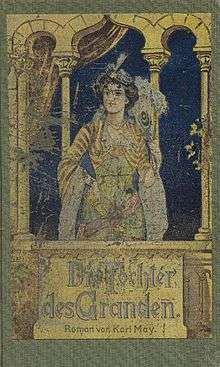
May wrote five large (many thousands of pages) colportage novels which he published either anonymously or under pseudonym between 1882 and 1888.
- Das Waldröschen (1882–84, a part was later revised for Old Surehand II)
- Die Liebe des Ulanen (1883–85)
- Der verlorne Sohn oder Der Fürst des Elends (1884–86)
- Deutsche Herzen (Deutsche Helden) (1885–88)
- Der Weg zum Glück (1886–88)
From 1900 to 1906, Münchmeyer's successor Adalbert Fischer published the first book editions. These were revised by third hand and published under May's real name instead of pseudonym. This edition was not authorised by May and he tried to stop the publication.[8]
Travel stories
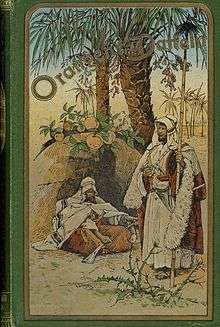
Thirty-three volumes of Carl May's Gesammelte Reiseromane, (Karl May's Gesammelte Reiseerzählungen) were published from 1892 to 1910 by Friedrich Ernst Fehsenfeld. Most had been previously published in Deutscher Hausschatz, but some were new. The best known titles are the Orient Cycle (volumes 1 - 6) and the Winnetou-Trilogy (volumes 7 - 9). Beyond these shorter cycles, the works are troubled by chronological inconsistencies arising when original articles are revised for book editions.
- Durch Wüste und Harem (1892, since 1895 titled Durch die Wüste)
- Durchs wilde Kurdistan (1892)
- Von Bagdad nach Stambul (1892)
- In den Schluchten des Balkan (1892)
- Durch das Land der Skipetaren (1892)
- Der Schut (1892)
- Winnetou I (1893, also titled Winnetou der Rote Gentleman I)
- Winnetou II (1893, also titled Winnetou der Rote Gentleman II)
- Winnetou III (1893, also titled Winnetou der Rote Gentleman III)
- Orangen und Datteln (1893, an anthology)
- Am Stillen Ocean (1894, an anthology)
- Am Rio de la Plata (1894)
- In den Cordilleren (1894)
- Old Surehand I (1894)
- Old Surehand II (1895)
- Im Lande des Mahdi I (1896)
- Im Lande des Mahdi II (1896)
- Im Lande des Mahdi III (1896)
- Old Surehand III (1897)
- Satan und Ischariot I (1896)
- Satan und Ischariot II (1897)
- Satan und Ischariot III (1897)
- Auf fremden Pfaden (1897, an anthology)
- Weihnacht! (1897)
- Im Reiche des silbernen Löwen I (1898)
- Im Reiche des silbernen Löwen II (1898)
- Am Jenseits (1899)
May's ouvre includes some shorter travel stories, which were not published within this series (for example, Eine Befreiung in Die Rose von Kaïrwan, 1894). After foundation of the Karl May Press in 1913, works in Gesammelte Werke were revised (sometimes extensively) and many received new titles. Texts (other than those from Fehsenfeld Press) were also added to the new series.
Stories for young readers
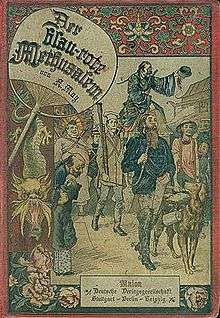
These stories were written from 1887 to 1897 for the magazine Der Gute Kamerad. Most of the stories are set in the Wild West, but Old Shatterhand is just a figure and not the first-person narrator as he is in the travel stories. The best known volume is Der Schatz im Silbersee. In the broadest sense the early works Im fernen Westen and Der Waldläufer belong to these category.
- Der Sohn des Bärenjägers (1887, since 1890 within Die Helden des Westens)
- Der Geist des Llano estakata (1888, since 1890 correctly titled as Der Geist des Llano estakado within Die Helden des Westens)
- Kong-Kheou, das Ehrenwort (1888/89, since 1892 titled Der blaurote Methusalem)
- Die Sklavenkarawane (1890)
- Der Schatz im Silbersee (1891)
- Das Vermächtnis des Inka (1892)
- Der Oelprinz (1894, since 1905 titled as Der Ölprinz)
- Der schwarze Mustang (1897)
- Replies to letters from readers in Der Gute Kamerad.
Mature work

May's mature work dates to 1900, after his travels to the East.[9] Many of them were published by Fehsenfeld.
- Himmelsgedanken (1900, poem collection)
- Im Reiche des silbernen Löwen III (1902)
- Erzgebirgische Dorfgeschichten (1903, anthology)
- Im Reiche des silbernen Löwen IV (1903)
- Und Friede auf Erden! (1904)
- Babel und Bibel (1906, drama)
- Ardistan und Dschinnistan I (1909)
- Ardistan und Dschinnistan II (1909)
- Winnetou IV (1910)
- Mein Leben und Streben (1910, autobiography)
- Schamah (1907) and other short stories.
- Briefe über Kunst (1907) and other articles.
- "Karl May als Erzieher" und "Die Wahrheit über Karl May" oder Die Gegner Karl Mays in ihrem eigenen Lichte (1902) and other legal proceedings.
Other works
May was a member of the "Lyra" choir in about 1864 and composed musical works including a version of Ave Maria and Vergiss mich nicht within Ernste Klänge, 1899).[10]
During his last years, May lectured on his philosophic ideas.
- Drei Menschheitsfragen: Wer sind wir? Woher kommen wir? Wohin gehen wir? (Lawrence, 1908)
- Sitara, das Land der Menschheitsseele (Augsburg, 1909)
- Empor ins Reich der Edelmenschen (Vienna, 1912)
- Posthumous publications of fragments of stories and dramas, lyrics, musical compositions, library catalogue and letters.
Reception
Number of copies and translations
It is stated that Karl May is the "most read writer of German tongue". The total number of copies published is about 200 million, half in German.[11]
May's first translated work was the first half of the Orient Cycle into a French daily in 1881.[12] Since that time, May's work has been translated into more than thirty languages including Latin, Esperanto and Volapük. In the 1960s, UNESCO said May was the most translated German writer.[11] His most popular translations are Czech, Hungarian and Dutch.[12] In 2001, Nemsi Books Publishing Company, Pierpont, South Dakota, was one of the first English publishing houses to produce the unabridged translations of May's ouvre. There are also braille editions[11] and editions read for the visually impaired.[13]
Influence
May had a substantial influence on a number of well-known German-speaking people and on the German population itself.[14] The popularity of his writing, and indeed, his (generally German) protagonists, are seen as having filled a lack in the German psyche which had few popular heroes until the 19th Century.[15] His readers longed to escape from an industrialised capitalist society, an escape which May offered.[16] May "helped shape the collective German dream of feats far beyond middle-class bounds."[15] and contributed to the popular image of Native Americans in German-speaking countries.
The name Winnetou has an entry in the German dictionary, Duden. The wider influence on the populace also surprised US occupation troops after World War II, who realised that thanks to May, "Cowboys and Indians" were familiar concepts to local children (though fantastic and removed from reality).[14]
Many well-known German-speaking people used May's heroes as models in their childhood.[17] Albert Einstein enjoyed May's books and said, "My whole adolescence stood under his sign. Indeed, even today, he has been dear to me in many a desperate hour..."[15]
Adolf Hitler was an admirer, who noted in Mein Kampf that the novels "overwhelmed" him as a boy, going as far as to ensure "a noticeable decline" in his school grades. According to an anonymous friend, Hitler attended the lecture given by May in Vienna in March 1912 and was enthusiastic about the event.[18] Ironically, the lecture was an appeal for peace, also heard by Nobel Peace Prize laureate Bertha von Suttner. Claus Roxin doubts the anonymous description, because Hitler had said much about May, but not that he had seen him.[19] Hitler defended May against critics in the men's hostel where he lived in Vienna, as the evidence of May's earlier time in jail had come to light; although it was true, Hitler confessed, that May had never visited the sites of his American adventure stories, this made him a greater writer in Hitler's view since it showed the author's powers of imagination. May died suddenly only ten days after the lecture, leaving the young Hitler deeply upset.[20] Hitler later recommended the books to his generals and had special editions distributed to soldiers at the front, praising Winnetou as an example of "tactical finesse and circumspection",[21] though some note that the latter claims of using the books as military guidance are not substantiated.[15] However, as told by Albert Speer, "when faced by seemingly hopeless situations, he [Hitler] would still reach for these stories," because "they gave him courage like works of philosophy for others or the Bible for elderly people."[21] Hitler's admiration for May led the German writer Klaus Mann to accuse May of having been a form of "mentor" for Hitler.[14] In his admiration, Hitler ignored May's Christian and humanitarian approach and views completely, not mentioning his relatively sympathetic description of Jews and other persons of non-Northern European ancestry.
The fate of Native Americans in the United States was used during the world wars for anti-American propaganda. The National Socialists in particular tried to use May's popularity and his work for their purposes.[15]
Influence on other authors
The German writer Carl Zuckmayer was intrigued by May's Apache chief and named his daughter Maria Winnetou.[11] Max von der Grün said he read May as a young boy. When asked whether reading May's books had given him anything, he answered, "No. It took something away from me. The fear of bulky books, that is."[22] Heinz Werner Höber, the twofold Glauser prize winner, was a follower of May. He said, "When I was about 12 years old I wrote my first novel on Native Americans which was, of course, from the beginning to the end completely stolen from Karl May." He had pleaded with friends to get him to Radebeul "because Radebeul meant Karl May". There he was deeply impressed by the museum and said, "My great fellow countryman from Hohenstein-Ernstthal and his immortal heroes have never left me ever since."[23]
Adaptations
May's poem Ave Maria (1896) was set to music in at least 19 versions. Other poems, especially from the collection Himmelsgedanken were also set to music. Carl Ball wrote Harp Clangs for the drama Babel und Bibel for May. The Swiss composer Othmar Schoeck adapted Der Schatz im Silbersee for opera. May's concepts, such as Winnetou's death inspired musical works.[24]
The first stage adaptation of May's work was Winnetou (1919) by Hermann Dimmler. Dimmler and Ludwig Körner made revised editions of the play. Different novel revisions have been played on outdoor stages since the 1940s. The Karl May Festival in Bad Segeberg has been held every summer since 1952 and in Lennestadt-Elspe since 1958. At these festivals, Pierre Brice has played Winnetou. Another festival has been conducted on a rock stage in Rathen, in Saxon Switzerland near Radebeul in 1940 and then since 1984.[25]
In 1920, May's friend Marie Luise Droop, her husband Adolf Droop and the Karl May Press founded Ustad-Film, a production company. Ustad-film made three silent movies (Auf den Trümmern des Paradieses, Die Todeskarawane and Die Teufelsanbeter) after the Orientcycle. The company became bankrupt in 1921 and the films are lost.[11] In 1936 a first sound movie Durch die Wüste was shown. Die Sklavenkarawane (1958) and its sequel Der Löwe von Babylon (1959) were the first colour movies.
From 1962 - 1968, a series of May movies were made.[26] While most of the seventeen movies of this series were Wild West movies (beginning with Der Schatz im Silbersee), three were based on the Orientcycle and two on Das Waldröschen. Most of these movies were made separately by the two competitors Horst Wendlandt and Artur Brauner. Several actors were employed, including Lex Barker (Old Shatterhand, Kara Ben Nemsi, Karl Sternau), Pierre Brice (Winnetou), Stewart Granger (Old Surehand), Milan Srdoč (Old Wabble) and Ralf Wolter (Sam Hawkens, Hadschi Halef Omar, André Hasenpfeffer). The film score by Martin Böttcher and the landscape of Yugoslavia are associated with the movies. Other movies such as Die Spur führt zum Silbersee (1990) and TV productions such as Das Buschgespenst (1986) and the television series Kara Ben Nemsi Effendi (1973) were produced. The productions vary from the original written works.[26]
May's works (about three hundred) have been adapted for audio dramas, particularly in the 1960s.[11][13] The first, Der Schatz im Silbersee was written by Günther Bibo in 1929.[11] There are also Czech and Danish versions of the audio dramas.[13] In 1988, Der Schatz im Silbersee was read by Gert Westphal and published as an audiobook. Wann sehe ich dich wieder, du lieber, lieber Winnetou? (1995) is a compendium of Karl May texts read by Hermann Wiedenroth.[13]
In the 1960s and 1970s, May's works were adapted for German comics including an eight comic series based on Winnetou and a further nine titled Karl May (1963–1965). The series was drawn by Helmut Nickel and Harry Ehrt and published by Walter Lehning Verlag. Eighty-seven issues of the Flemish comic, Karl May, were published by Standaard Uitgeverij from 1862 to 1987. The series was drawn by the studio of Willy Vandersteen. Comics were also produced in Czechoslovakia, Denmark, France, Mexico, Spain and Sweden.[27]
May's life has been the subject of screen works, novels and a stage play, including
- Freispruch für Old Shatterhand (1965, directed by Hans Heinrich)
- Karl May (1974, directed by Hans-Jürgen Syberberg)
- Karl May (1992, directed by. Klaus Überall, a television series in 8 episodes)
- Swallow, mein wackerer Mustang (1980) by Erich Loest
- Vom Wunsch, Indianer zu werden. Wie Franz Kafka Karl May traf und trotzdem nicht in Amerika landete (1994) by Peter Henisch
- Old Shatterhand in Moabit (1994) by Walter Püschel
- Karl May und der Wettermacher (2001) by Jürgen Heinzerling
- Die Taschenuhr des Anderen by Willi Olbrich.
Copies, parodies, and sequels
May was copied or parodied during his lifetime. Some wrote similar wild west stories. Others such as Franz Treller published under May's name.[28] Novelisations of May's characters include
- Hadschi Halef Omar (2010) Jörg Kastner, describes the first contact of the titular character with Kara Ben Nemsi.
- In Mekka (1923) Franz Kandolf, a sequel to Am Jenseits (Karl May's Gesammelte Werke volume 50.)
- "Die Schatten des Schah-in-Schah" (2006) Heinz Grill, an alternative to Im Reiche des silbernen Löwen III/IV.
- Winnetous Testament Jutta Laroche and Reinhard Marheinecke, a series of eight volumes as a sequel to Winnetou IV.
- Der Schuh des Manitu (2001) Michael Herbig, a parody on the Karl May Films of the 1960s.
Legacy
Asteroid 15728 Karlmay is named in May's honour.[29]
Karl May institutions
Karl May Foundation
In his will, May made his second wife, Klara, his sole heiress. He instructed that after her death all of his property and any future earnings from his work should go to a foundation. This foundation should support the education of the gifted poor including writers, journalists and editors. One year after May's death, on 5 March 1913, Klara May established the "Karl May Foundation" ("Karl-May-Stiftung"). Contributions have been made since 1917. Klara and Karl May's estate went to the foundation. The foundation established the Karl May Museum to maintain the Villa Shatterhand, the estates, the collections and May's tomb.[30][31] In 1960, the Karl May Foundation received the Karl May Press.[31]
Karl May Press
On 1 July 1913, Klara May, Friedrich Ernst Fehsenfeld (May’s main publisher) and the jurist Euchar Albrecht Schmid established the "Foundation Press Fehsenfeld & Co." ("Stiftungs-Verlag Fehsenfeld & Co.") in Radebeul. In 1915, the name changed to "Karl May Press" ("Karl-May-Verlag" (KMV)). The KMV consolidated the rights to May's works from internal discord and from other publishers.[32] Third hand revisions of these texts were added to the series Karl May’s Gesammelte Reiseerzählungen, which was renamed to Karl May’s Gesammelte Werke (und Briefe). The existing 33 volumes of the original series were also revised, some extensively. Until 1945 there were 65 volumes. The press is exclusive to May's work and subsidiary literature. Besides the Gesammelte Werke (the classical "green volumes"), which have 91 volumes today, the press has a huge reprint programme.
The Karl May Press aims to rehabilitate May from literary criticism and to support of the Karl May Foundation. In 1921, Fehsenfeld left and in 1960, the foundation fell to Klara May's estate and thus, the press is owned by the Schmid family. In 1959, due to censorship in the Soviet occupation zone and East Germany, the press moved to Bamberg (West Germany). In 1963, when copyright ended, the press began commercialising May's works. After German reunification, in 1996, the press took a second office in Radebeul. The name "Karl May" is registered trade mark of the "Karl May Verwaltungs- und Vertriebs-GmbH", which belongs to the Karl May Press.[32]
Museums
Radebeul
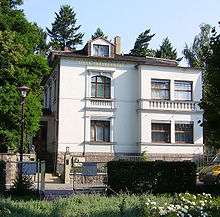

The "Karl May Museum" in Radebeul was founded on 1 December 1928 in Villa Bear Fat (Villa Bärenfett) focussing on the history and life of Native Americans. Villa Barenfett was a log house in the garden of Villa Shatterhand. Its inspiration was the works of Patty Frank (Ernst Tobis). Karl May's collection about Native Americans, contributed by Klara May and the collection of Patty Frank were combined. Frank was the first curator and a home for life at Villa Bear Fat. In 1956, during the time of the GDR the museum was renamed the Native Americans Museum of the Karl May Foundation in 1956. In 1962, the Karl May related exhibits were removed. In 1984, the museum returned to its former name and the street it was on was renamed "Karl May Street".
Since 1985, Villa Shatterhand has displayed an exhibition about Karl May. There is also a research library, a work room and a parlour ("Sascha Schneider Room"). These rooms retain their original furnishings. Also displayed are replicas of guns and a bust of Winnetou. May's fruit garden has become the "Karl May Grove" ("Karl-May-Hain").[33]
Hohenstein-Ernstthal
The "Karl May House" ("Karl-May-Haus") is the three centuries old weaver house, where May was born. Since 12 March 1985, it has been a memorial and museum. It shows an original weaving room and non-German book editions. The garden has been arranged according to May's description in his memoirs.
Opposite the house is the International Karl May Heritage Center ("Karl-May-Begegnungsstätte"), which is used for events and special exhibitions. In Hohenstein-Ernstthal, called "Karl May Home Town" since 1992, every May related place has a commemorative plaque. These places are connected by a "Karl May Path" ("Karl-May-Wanderweg"). Outside the city lies the "Karl May Cave" ("Karl-May-Höhle"), where May found shelter during his criminal times.[34]
Societies
In the 1890s, there were Karl May clubs.[35] Today, various entities focus on research about the author.[36] These organisations exist in German-speaking regions, the Netherlands, Australia and Indonesia. While such societies are responsible for the release of most May related periodicals, for example, Der Beobachter an der Elbe, Karl-May-Haus Information, Wiener Karl-May-Brief, and Karl May in Leipzig, the magazine Karl May & Co. is published independently.
The "Karl May Society" (KMG), founded on 22 March 1969, is the largest organisation with approximately 1800 members.[37] The KMG publishes Jahrbuch, Mitteilungen, Sonderhefte der Karl-May-Gesellschaft, and KMG-Nachrichten and reprints. Since 2008 and in cooperation with the Karl May Foundation and the Karl May Press, the KMG has published the critiqued edition of "Karl Mays Werke". This project was initiated by Hans Wollschläger and Hermann Wiedenroth in 1987.[8][38]
References
- ↑ May K. Mein Leben und Streben (My Life and Aspirations") Karl May, 2014 in German ISBN 6050342989, 9786050342987.
- 1 2 3 Sudhoff D. and Steinmetz H. Karl-May-Chronik Karl-May-Verlag, 2006. ISBN 3780201704, 9783780201706.
- ↑ Bartsch E. and Wollschläger H. Karl May's Orientreise 1899-1900 in In fernen Zonen: Karl Mays Weltreisen. (In remote areas : Karl May's world travel) Karl-May-Verlag, 1999, Original from Indiana University, digitized 20 Jan 2011. ISBN 3780200821, 9783780200822.
- ↑ Heermann C. Winnetous Blutsbruder: Karl-May-Biografie. Karl-May-Verlag, 2002. ISBN 3780201615, 9783780201614.
- 1 2 http://www.bild.de/regional/dresden/karl-may/karl-may-starb-an-blei-45126002.bild.html
- ↑ May K. Letter to Herbert Friedländer (13 April 1906) in Wohlgschaft H. Karl May, Leben und Werk, Buecherhaus Bargfeld, Germany, 2005 p1555f. ISBN 3930713934.
- ↑ Lowsky M. Karl May Metzler, Stuttgart, 1987, vol 231 p38.
- 1 2 Wehnert J. Der Text. In Ueding: Karl-May-Handbuch, p116 - 130.
- ↑ Schmid E. A. Gestalt und Idee. p 367-420 in Karl May. ICH 39th Edition Verlag, Bamberg, 1995
- ↑ Kühne H. and Lorenz C. F. Karl May und die Musik. Verlag, Bamberg and Radebeul, 1999.
- 1 2 3 4 5 6 7 Petzel M. and Wehnert J. Das neue Lexikon rund um Karl May. Lexikon Imprint Verlag, Berlin 2002.
- 1 2 von Thüna U. Übersetzungen in Ueding G.Karl-May-Handbuch Königshausen & Neumann, 2001 p519 - 522. ISBN 3826018133, 9783826018138.
- 1 2 3 4 Karl May audio drama database
- 1 2 3 Ich bin ein Cowboy The Economist, 24 May 2001.
- 1 2 3 4 5 Tales Of The Grand Teutons: Karl May Among The Indians. The New York Times, 4 January 1987
- ↑ Camurat D. The American Indian in the Great War, Real and Imagined
- ↑ Müller E. Aufgespießt in KMG-Nachrichten
- ↑ Anonymus Mein Freund Hitler in Moravsky ilustrovany zpravodaj. 1935, No. 40 p10.
- ↑ Roxin C. Letter dated 24 February 2004. Cited in Wohlgschaft Karl May - Leben und Werk, p. 2000.
- ↑ Hamman B. Hitler's Vienna: A Dictator's Apprenticeship Oxford University Press, New York 1999 p382 - 385 ISBN 0-19-512537-1.
- 1 2 Grafton A. Mein Buch The New Republic, December 2008.
- ↑ Thor Heyerdahl Gymnasium, Anecdotes in German.
- ↑ Eik J. Der Mann, der Jerry Cotton war. Erinnerungen des Bestsellerautors Heinz Werner Höber. Das Neue Berlin, Berlin, 1996. EAN 9783359007999
- ↑ Kühne H. Vertonungen in Ueding's Karl-May-Handbuch p532 - 535.
- ↑ Hatzig H. Dramatisierungen in Ueding's Karl-May-Handbuch, p523 - 526.
- 1 2 Hatzig H. Verfilmungen in Ueding's Karl-May-Handbuch p527 - 531.
- ↑ Petzel M. Comics und Bildergeschichten in Ueding: Karl-May-Handbuch p539 - 545.
- ↑ Wehnert J. Fortsetzungen, Ergänzungen und Bearbeitungen. in Karl-May-Handbuch p509 - 511.
- ↑ 15728 Karlmay NASA Jet Propulsion Laboratory – Small-Body Database. Accessed 16 October 2012.
- ↑ Schmid E. Karl Mays Tod und Nachlaß. in Karl May ICH 39th edition. Karl-May-Verlag, Bamberg, 1995, pp. 327–365.
- 1 2 Wagner R. Karl-May-Stiftung (Radebeul) in Ueding: Karl-May-Handbuch, pp. 549–551.
- 1 2 Wehnert J. Der Karl-May-Verlag in Ueding: Karl-May-Handbuch p554 - 558.
- ↑ Wagner R. Karl-May-Museum (Radebeul) in Ueding: Karl-May-Handbuch, p547 - 549.
- ↑ Neubert A. Karl-May-Haus (Hohenstein-Ernstthal) in Karl-May-Handbuch p546 - 547.
- ↑ Wohlgschaft: Karl May – Leben und Werk. p. 1029
- ↑ Heinemann E. Organe und Perspektiven der Karl-May-Forschung. In: Ueding: Karl-May-Handbuch, p559 - 564.
- ↑ Satzung der Karl-May-Gesellschaft e.V. 2 March 2010.
- ↑ Edition plannings.
Further reading
- Bugmann M. Savage To Saint: The Karl May Story. Lulu Press Inc, 2016 edition, EAN 5800115753823, Lulu.com ID 18655619 (A first English biography of Karl May).
- Frayling C. Spaghetti Westerns: Cowboys and Europeans from Karl May to Sergio Leone. Routledge, London and Boston 1981; revised edition, Taurus, London and New York 2006, ISBN 978-1-84511-207-3.
- Grams G "Was Karl May in Canada? The works of Max Otto: A German writer's "Absurb Picture of Canada" Yearbook of German-American Studies, Volume 42 2007, p69 - 83.
- Grams G. This terrible Karl May in the Wild West
- Schneider, Tassilo. "Finding a new Heimat in the Wild West: Karl May and the German Western of the 1960s." Journal of Film and Video (1995): 50-66. in JSTOR
- Sammons J. Ideology, nemesis, fantasy: Charles Sealsfield, Friedrich Gerstäcker, Karl May, and other German novelists of America. University of North Carolina Press, Chapel Hill 1998, ISBN 0-8078-8121-X.
- Schwerla K. Kanada I'm Faltboot Alberta History Volume 56(1) 2008 p10 - 13.
In German
- Wiedenroth H. and Wollschlager H. Karl Mays Werke: historisch-kritische Ausgabe (Karl May's Works, an historical critique.) various publishers.
- May K. Mein Leben und Streben (My Life and Aspirations.) (1910) Karl May, 2014. ISBN 6050342989.
- My life and my efforts. Karl May company English version website.
- Michalak M. My Life and My Mission Nemsi Books 2007. ISBN 0-9718164-7-6 and ISBN 978-0-9718164-7-3.
- Plaul H. Illustrierte Karl-May-Bibliographie. Unter Mitwirkung von Gerhard Klußmeier. Saur, Munich, London, New York, Paris 1989, ISBN 3-598-07258-9 (in German).
- Sudhoff D. and Steinmetz H. Karl-May-Chronik (5 volumes and companion book). Karl-May-Verlag, Bamberg and Radebeul 2005–2006, ISBN 3-7802-0170-4 (in German).
- Ueding G. (Ed.) Karl-May-Handbuch. Second enlarged and revised edition. Königshausen & Neumann, Würzburg 2001, ISBN 3-8260-1813-3 (in German).
- Wohlgschaft H. Karl May, Leben und Werk Bücherhaus, Bargfeld 2005, ISBN 3-930713-93-4 (in German).
- Wollschläger H. Karl May. Grundriß eines gebrochenen Lebens (1965) Wallstein, Göttingen 2004 ISBN 3-89244-740-3 (in German).
- Schiedt H. Karl May oder Die Macht der Phantasie. Beck Verlag, München 2011 ISBN 978-3-406-62116-1 (in German)
External links
| Wikimedia Commons has media related to Karl May. |
| German Wikisource has original text related to this article: |
- Karl May Gesellschaft KM Society.
- The 100th Anniversary of Karl May's Death: Literary Genius or Man of Legendary Hubris?
- Hermesmeier W. Karl May in German.
- Karl May bibliographic database in German.
- Karl Friedrich May Papers Gettysburg College.
- Karl-May-Wiki in German
- Karl May BBC Radio 4 documentary.
- Karl May Foundation in German.
- Karl May Press in German.
- Karl May Museum in Radebeul in German.
- Museum flyer in English.
- Karl May House in Hohenstein-Ernstthal (Museum) in English.
- Karl May societies. in German.
- Free scores by Karl May at the International Music Score Library Project
- Free scores by Karl May in the Choral Public Domain Library (ChoralWiki)
- Literature by and about Karl May in the German National Library catalogue
- Works by Karl May at Project Gutenberg
- Works by or about Karl May at Internet Archive
- Works by Karl May at LibriVox (public domain audiobooks)
